CLIMATE REFUGEES: THE INVISIBLE VICTIMS OF CLIMATE CHANGE
When we think of climate change, its most direct effects immediately come to mind: rising sea levels, intense flooding or persistent droughts.
However, more and more studies are showing how such events cascade additional adverse effects as well. In particular, it is argued that climate change plays a central role in shaping present and future migration flows, leading to the emergence of a new category of migrants: climate refugees.
The goal of this article is to shed some light on the subject by answering a few simple questions. What is the scientific evidence proving the link between climate change and migration? Who are the ‘climate refugees’? What is the existing legal framework on the subject?
- The causal link between climate change and migration
Norman Myers was among the first to theorize the link between climate change and migration. In his studies he observed that the deterioration of natural habitats could be a determining factor in the decision of those living there to relocate elsewhere. Today his theories find full confirmation in studies by major research centres and international organizations.
The International Displacement Monitoring Centre (IDMC) notes that the effects of climate change such as desertification, rising temperatures, loss of biodiversity, intensified adverse weather events and rising sea levels are gradually reducing the chances of having access to food and water, as well as making certain areas of the planet inhospitable to life. According to IDMC’s 2020 projections, these events alone gave rise to about 30 million relocations in 149 countries.
Similarly, the UN Refugee Agency (UNHCR) warns that without ambitious climate policies, people forced to migrate could double to a number of about 200 million displaced people by 2050.
As well noted by the International Organization for Migration (IOM), migration is merely a strategy for humans to adapt to climate challenges when mitigation and adaptation measures already in place can no longer cope. Migration reduces the risk of exposure to the climate factor and increases the survival chances of the community affected by the environmental stress.
In this context it should be made clear, however, that climate change-induced migration will be predominantly internal and concentrated in the so-called Global South. Pre-existing conditions of economic and social inequality make and will make developing countries much more vulnerable to climate change. Africa, Asia and Latin America will be the most exposed geographic areas.
2. The definition of a climate refugee
At present, there is no unanimous view on what terminology to use to identify those who migrate due to the effects of climate change.
In 2008, Biermann and Boas coined the term ‘climate refugee’ which, to date, seems to be the most popular in public opinion as well. This is because it is effective in capturing the link between climate change and migration and indirectly suggesting the responsibility of industrialized countries in causing it. By this term, the two researchers define those ‘people who must leave their habitats, either suddenly or in the immediate future due to sudden or gradual alterations in their natural environment caused by at least one of three impacts of climate change: sea level rise, extreme weather events, and drought or water scarcity.’ However, this definition finds resistance.
IOM, for example, complains of possible confusion with the traditional ‘refugee’ category of the 1951 Geneva Convention. In its own glossary it proposes the term ‘environmental migrants’ albeit providing a description of the category similar to that of Biermann and Boas. There is, in addition, the will of the victims of climate change to be taken into account. For example, Pacific peoples who are already facing the effects of sea level rise reject such categorizations. This is because, among other reasons, such discourse risks diverting attention from the first real global goal: to stop climate change from driving them off their lands.
3. The existing legal framework
Although the term ‘climate refugees’ is used extensively it should be made clear that it is not a legal definition. Those who chew a modicum of law know that the absence of the legal category results in its invisibility before the law. If, however, for those who migrate within their own country there are domestic regulations, humanitarian law or the mechanisms outlined in the UN Guiding Principles on Internal Displacement, those who cross the borders of other states face a real normative gap.
Indeed, the main international refugee treaty, the 1951 Geneva Convention, stipulates that ‘refugee’ status is granted to those who cross the border because of ‘a well-founded fear of persecution’ where such persecution is due to one of the five reasons identified in the standard: ‘on grounds of race, religion, nationality or membership of a particular social group or political opinion.’ Clearly, this definition does not include the effects of climate change.
Similarly, the European Union (EU) asylum system is not equipped to accommodate this category of refugees. A recent study notes the failure of the EU to change its legislation in accommodating ‘climate refugees.’ Instead, it appears to be much more focused on preventing migration from countries of origin and increasing its border security measures. The approach has not changed even at the time of the New Pact on Migration and Asylum.This does not mean that nothing has been done to date. The United Nations, for example, has launched initiatives and programs to address the issue, such as the Nansen Initiative and the Global Compact on Migration, which explicitly recognize the climate change-migration causal link and provide states with instructions for protecting climate refugees. Thus, at the EU level, studies and research such as the recent CLImate Change Induced Migration (CLICIM) project are already underway. However, these initiatives do not introduce binding protection obligations for states. So, the regulatory gap still persists and yet climate change is already reaping its victims.
Article by Erika Moranduzzo, Italian Climate Network Volunteer

